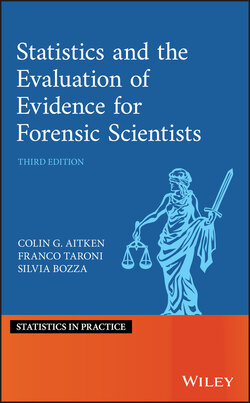Читать книгу Statistics and the Evaluation of Evidence for Forensic Scientists - Franco Taroni - Страница 45
Example Example 1.4
Оглавление1 Consider four events , and . Event is that the area of Lithuania is no more than , is the event that the area of Lithuania is greater than but no more than , is the event that the area of Lithuania is greater than but no more than , and is the event that the area of Lithuania is greater than . Assign probabilities to each of these four events. Remember that these are four mutually exclusive events and that the four probabilities should add up to 1. Which do you consider the most probable and what probability do you assign to it? Which do you consider the least probable and what probability do you assign to it?
2 Now, consider the information that Lithuania is the 25th largest country in Europe (excluding Russia). Use this information to reconsider your probabilities in part (a).
3 Consider the information that Estonia, which is the 30th largest country in Europe, has an area of , and use it to reconsider your probabilities from the previous part.
4 Consider the information that Austria, which is the 21st largest country in Europe has an area of , and use it to reconsider your probabilities from the previous part.
The area of Lithuania is given at the end of the chapter.
Example 1.5
1 Imagine you are on a jury. The trial is about to begin but no evidence has been led. Consider the two events: the defendant is truly guilty; and , the defendant is innocent. What are your probabilities for these two events?
2 The defendant is a tall Caucasian male. An eyewitness says he saw a tall Caucasian male running from the scene of the crime. What are your probabilities now for and ?
3 A bloodstain at the scene of the crime was identified as coming from the criminal. A partial DNA profile has been obtained, with proportion 2% in the local Caucasian population. What are your probabilities now for and ?
4 A window was broken during the commission of the crime. Fragments of glass were found on the defendant's clothing of a similar refractive index to that of the crime window. What are your probabilities now for and ?
5 The defendant works as a demolition worker near to the crime scene. Windows on the demolition site have refractive indices similar to the crime window. What are your probabilities now for and ?
This example is designed to mimic the presentation of evidence in a court case. Part (a) asks for a prior probability of guilt before the presentation of any evidence. It may be considered as a question concerning the understanding of the dictum ‘innocent until proven guilty’. See Section 2.7 for further discussion of this with particular reference to the logical problem created if a prior probability of zero is assigned to the event that the suspect is guilty.
Part (b) involves two parts. First, the value of the similarity in physical characteristics between the defendant and the person running from the scene of the crime, assuming the eyewitness is reliable, has to be assessed. Secondly, the assumption that the eyewitness is reliable has to be assessed.
In part (c) it is necessary to check that the defendant has the same profile. It is not stated that he has but if he has not he should never have been a defendant. Secondly, is the local Caucasian population the relevant population? The evaluation of evidence of the form in (c) is discussed in Chapter 5.
The evaluation of refractive index measurements mentioned in (d) is discussed in Chapter 7 . Variation both within and between windows has to be considered. Finally, how information about the defendant's lifestyle may be considered is discussed in Chapter 6 .
It should be noted that the questions asked initially in Example 1.5 are questions that should be addressed by the judge and/or jury. The forensic scientist is concerned with the evaluation of their evidence, not with probabilities of guilt or innocence. These probabilities are the concern of the jury. The jury combines the evidence of the scientist with all other evidence and uses its judgement to reach a verdict. The theme of this book is the evaluation of evidence. Discussion of issues relating to guilt or otherwise of PoIs will not be very detailed.
As a tail piece to this chapter, the area of Lithuania is .
